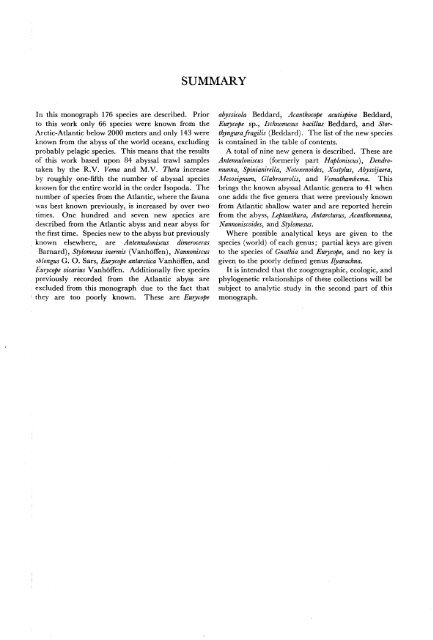The Isopods of Abyssal Depths in the Atlantic Ocean
The Isopods of Abyssal Depths in the Atlantic Ocean
The Isopods of Abyssal Depths in the Atlantic Ocean
Create successful ePaper yourself
Turn your PDF publications into a flip-book with our unique Google optimized e-Paper software.
In this monograph 176 species are described. Prior<br />
to this work only 66 species were known from <strong>the</strong><br />
Arctic-<strong>Atlantic</strong> below 2000 meters and only 143 were<br />
known from <strong>the</strong> abyss <strong>of</strong> <strong>the</strong> world oceans, exclud<strong>in</strong>g<br />
probably pelagic species. This means that <strong>the</strong> results<br />
<strong>of</strong> this work based upon 84 abyssal trawl samples<br />
taken by <strong>the</strong> R.V. Vema and M.V. <strong>The</strong>ta <strong>in</strong>crease<br />
by roughly one-fifth <strong>the</strong> number <strong>of</strong> abyssal species<br />
known for <strong>the</strong> entire world <strong>in</strong> <strong>the</strong> order Isopoda. <strong>The</strong><br />
number <strong>of</strong> species from <strong>the</strong> <strong>Atlantic</strong>, where <strong>the</strong> fauna<br />
was best known previously, is <strong>in</strong>creased by over two<br />
times. One hundred and seven new species are<br />
described from <strong>the</strong> <strong>Atlantic</strong> abyss and near abyss for<br />
<strong>the</strong> first time. Species new to <strong>the</strong> abyss but previously<br />
known elsewhere, are Antennuloniscus dimeroceras<br />
Barnard), Stylomesus <strong>in</strong>ermis (Vanh<strong>of</strong>fen), Nannoniscus<br />
oblongus G. O. Sars, Eurycope antarctica Vanh<strong>of</strong>fen, and<br />
Eurycope vicarius Vanh<strong>of</strong>fen. Additionally five species<br />
previously recorded from <strong>the</strong> <strong>Atlantic</strong> abyss are<br />
excluded from this monograph due to <strong>the</strong> fact that<br />
<strong>the</strong>y are too poorly known. <strong>The</strong>se are Eurycope<br />
SUMMARY<br />
abyssicola Beddard, Acanthocope acutisp<strong>in</strong>a Beddard,<br />
Eurycope sp., Ischnomesus bacillus Beddard, and Storthyngurafragilis<br />
(Beddard). <strong>The</strong> list <strong>of</strong> <strong>the</strong> new species<br />
is conta<strong>in</strong>ed <strong>in</strong> <strong>the</strong> table <strong>of</strong> contents.<br />
A total <strong>of</strong> n<strong>in</strong>e new genera is described. <strong>The</strong>se are<br />
Antennuloniscus (formerly part Haploniscus), Dendromunna,<br />
Sp<strong>in</strong>ianirella, Notoxenoides, Xostylus, Abyssijaera,<br />
Mesosignum, Glabroserolis, and Vemathambema. This<br />
br<strong>in</strong>gs <strong>the</strong> known abyssal <strong>Atlantic</strong> genera to 41 when<br />
one adds <strong>the</strong> five genera that were previously known<br />
from <strong>Atlantic</strong> shallow water and are reported here<strong>in</strong><br />
from <strong>the</strong> abyss, Leptanthura, Antarcturus, Acanthomunna,<br />
Nannoniscoides, and Stylomesus.<br />
Where possible analytical keys are given to <strong>the</strong><br />
species (world) <strong>of</strong> each genus; partial keys are given<br />
to <strong>the</strong> species <strong>of</strong> Gnathia and Eurycope, and no key is<br />
given to <strong>the</strong> poorly def<strong>in</strong>ed genus Ilyarachna.<br />
It is <strong>in</strong>tended that <strong>the</strong> zoogeographic, ecologic, and<br />
phylogenetic relationships <strong>of</strong> <strong>the</strong>se collections will be<br />
subject to analytic study <strong>in</strong> <strong>the</strong> second part <strong>of</strong> this<br />
monograph.

















